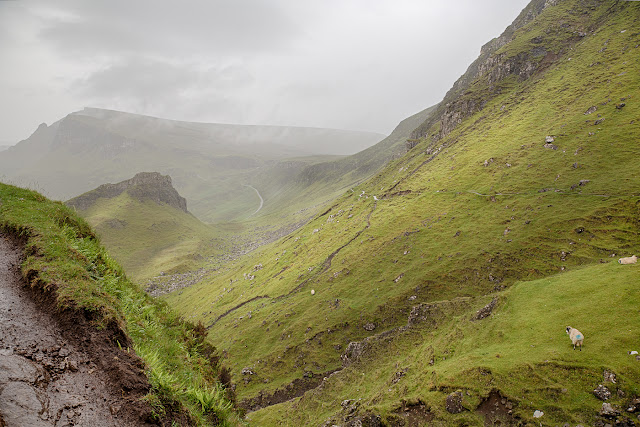I recently spent two days on the Isle of Skye where I had hoped to get some amazing images of the Quiraing. I set out to walk up the Quiraing but the weather seriously deteriorated so I turned back when I was only half way up. It's not obvious from this image but the rain was heavy.
 |
| The Quiraing |
A test shot showed that the light conditions were difficult with a very wide range of light intensities from bright patches in the sky to very dark shadows in the cliffs. In these circumstances one potential solution is to use an HDR (high dynamic range) process to merge multiple images where two of the shots are exposed correctly for the brightest parts and darkest parts of the scene, and other shots are correctly exposed for intermediate light intensities.
Successful HDR usually requires a tripod to ensure that the series of shots are well aligned with each other, but here I did not have a tripod. The solution was to brace against a convenient rock. Each of these images has been made using five shots in aperture priority mode with shutter speeds ranging from 1/320s to 1/20s, all at aperture f/8 and ISO 400.
With these settings I knew that the images would individually be sharp enough. My main worry was with camera movement between shots and whether the five images could be properly aligned. In the end I needn't have worried because the HDR software (Nik HDR Pro 2) does a good job aligning images taken under these conditions.
 |
| Return from Quiraing |
I do not like the unnatural look that I normally associate with HDR images; In order to obtain a relatively natural look I used the default settings throughout, but then did some further processing using Photoshop layers because output from HDR was rather flat.
 |
| Photoshop layers |
The various Photoshop layers are shown here. The bottom layer "Layer 0" is the output from the HDR process. I then added a dodge and burn layer. This is a blank layer filled with 50% gray with the blend mode set to "Overlay". A dodge and burn layer allows you to selectively lighten and darken parts of the image. Just use a soft brush with low opacity and flow (both set to about 20% here) and paint black or white onto the layer. I then added a curves layer and mask, "Curves 1", to selectively add local contrast. Finally I added a levels layer to adjust the white point ensuring that the entire image was not too dark.


